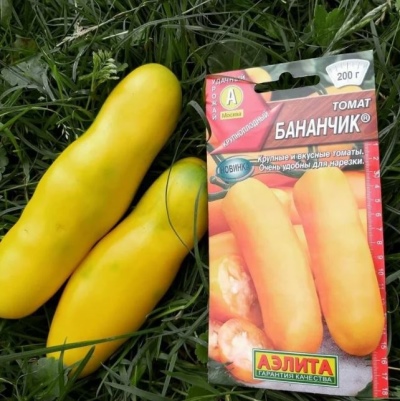
- Authors: Kachainik V.G., Gulkin M.N., Karmanova O.A., Matyunina S.V. (Agrofirma Aelita LLC)
- Year of approval: 2015
- Category: grade
- Growth type: indeterminate
- Appointment: universal
- Ripening period: late ripening
- Ripening time, days: 116-120
- Growing conditions: for open ground, for film greenhouses
- Bush height, cm: 160-180
- Leaves: long, dark green
Tomato Bananchik is a fairly new variety, which was bred by Agrofirma Aelita LLC. The variety has been approved for use only since 2015, but during this time it managed to acquire an army of fans among summer residents.
Description of the variety
The banana belongs to the indeterminate varieties. The height of the bush is from 160 to 180 cm. The leaves of the plant are long, dark green in color.
The main qualities of the fruit
In an unripe form, the skin of tomatoes is green, a green spot is observed on it. The ripe fruit is orange in color. The tomatoes are large, each weighing 110 g. The inflorescences are intermediate. The first inflorescence is laid above 6-7 leaves, the next ones - after 2-3 leaves.
Taste characteristics
The flesh of the fruit is yellow, firm, the taste is sweet. These tomatoes can be used both fresh and for pickling and pickling.
Ripening and fruiting
Banana belongs to varieties with a late ripening period. The first tomatoes can be removed after 116-120 days. Tomatoes are harvested from July to September.
Yield
It is a high-yielding variety that can yield 10.1-11.8 kg / m2.
The timing of planting seedlings and planting in the ground
Seedlings are planted in March; you can plant seedlings in a summer cottage in May-June.

Growing tomato seedlings is an extremely important process, because it largely depends on whether the gardener can harvest at all. All aspects must be taken into account, from seedbed preparation to planting in the ground.
Landing scheme
When growing seedlings, do not forget to soak the seeds in a weak solution of potassium permanganate in advance. Further, the planting material is germinated on a plate and placed in a special substrate. When growing seedlings, observe the following rules.
Water the young seedlings regularly with warm water under the root, try not to touch the stem and leaves with water.
After the appearance of 1-2 leaves, dive the seedlings.
When the time comes to plant seedlings on the site, choose a more convenient place for them. The crop will grow best in beds that are well lit by the sun and hidden from the wind.
Dig holes, add humus and water well. The sprouts are planted according to the scheme 3-4 plants per m2, 60x50 cm. After transplanting, moisten the planting site again, and then sprinkle with a layer of dry soil.

Growing and care
The plant of the presented variety can be cultivated both in open ground and in a film greenhouse. Agricultural engineering consists of several stages.
Regular watering. Do this process on a cloudy day or in the evening when the sun is not so hot. The plant especially needs irrigation during flowering, before fertilization and loosening.
Top dressing. Additional food is added every 10-12 days. Mineral or organic compounds are used as fertilizer.
Bush formation.A competently executed process will have a positive effect on the amount of the crop. The plant of this variety is formed into one stem.
Loosening and hilling. These activities are performed several times per season.




A plant needs different micronutrients at each stage of growth. All fertilizers can be divided into two groups: mineral and organic. Folk remedies are often used: iodine, yeast, bird droppings, eggshells.
It is important to observe the rate and period of feeding. This also applies to folk remedies and organic fertilizers.
Disease and pest resistance
The presented variety has high immunity against late blight, fusarium wilt, tobacco mosaic virus. However, this is a late-ripening variety, so preventive measures should not be ignored. After mid-summer, you can carry out two treatments, for example, copper sulfate, "Fitosporin" or folk remedies, for example, sour milk with iodine.
Insects do not like the pungent smell of tomato leaves, but the roots sometimes become a delicacy for the bear. To prevent the appearance of this pest, you should regularly loosen the soil and keep the area clean. Against the attacks of the bear, you need to immediately carry out treatment with special preparations - this insect is capable of destroying a large number of bushes in a short time.


Growing regions
The variety is unpretentious in care, therefore it is suitable for cultivation in the North, North-West, Central, Volgo-Vyatka, Central Black Earth Region, North Caucasian, Middle Volga, Nizhnevolzhsky, Ural, West Siberian, East Siberian and Far Eastern regions.

























































































